The Influence of Different Length Aluminum Foam Filling on Mechanical Behavior of a Square Thin-Walled Column
Abstract
1. Introduction
2. Crashworthiness Indicator
3. Materials and Models
4. Methodology of FEM
5. Experimental Studies
5.1. Foam Fabrication
5.2. Experimental Specimen
6. Results of Experimental Study
7. Results of Numerical Analysis
8. Conclusions
Author Contributions
Funding
Institutional Review Board Statement
Informed Consent Statement
Data Availability Statement
Acknowledgments
Conflicts of Interest
References
- Abramowicz, W. Thin-walled structures as impact energy absorbers. Thin-Walled Struct. 2003, 41, 91–107. [Google Scholar] [CrossRef]
- Bruski, D.; Burzyński, S.; Chróścielewski, J.; Jamroz, K.; Pachocki, Ł.; Witkowski, W.; Wilde, K. Experimental and numerical analysis of the modified TB32 crash tests of the cable barrier system. Eng. Fail. Anal. 2019, 104, 227–246. [Google Scholar] [CrossRef]
- Ferdynus, M.; Kotełko, M.; Urbaniak, M. Crashworthiness performance of thin-walled prismatic tubes with corner dents under axial impact—Numerical and experimental study. Thin-Walled Struct. 2019, 144, 106239. [Google Scholar] [CrossRef]
- Alexander, J.M. An approximate analysis of the collapse of thin cylindrical shells under axial loading. Q. J. Mech. Appl. Math. 1960, 13, 10–15. [Google Scholar] [CrossRef]
- Abramowicz, W.; Jones, N. Dynamic axial crushing of square tubes. Int. J. Impact Eng. 1984, 2, 263–281. [Google Scholar] [CrossRef]
- Abramowicz, W.; Jones, N. Dynamic progressive buckling of circulars and square tubes. Int. J. Impact Eng. 1986, 4, 243–270. [Google Scholar] [CrossRef]
- Hanssen, A.G.; Langseth, M.; Hopperstad, O.S. Static crushing of square aluminium extrusions with aluminium foam filler. Int. J. Mech. Sci. 1999, 41, 967–993. [Google Scholar] [CrossRef]
- Hanssen, A.G.; Langseth, M.; Hopperstad, O.S. Static and dynamic crushing of square aluminium extrusions with aluminium foam filler. Int. J. Impact Eng. 2000, 24, 347–383. [Google Scholar] [CrossRef]
- Kaczyński, P.; Ptak, M.; Gawdzińska, K. Energy absorption of cast metal and composite foams tested in extremely low and high-temperatures. Mater. Des. 2020, 196, 109114. [Google Scholar] [CrossRef]
- Hipke, T.; Hohlfeld, J.; Rybandt, S. Functionally Aluminum Foam Composites for Building Industry. Procedia Mater. Sci. 2014, 4, 133–138. [Google Scholar] [CrossRef]
- Gawdzińska, K.; Chybowski, L.; Nabiałek, M.; Szymański, P. A Study of Metal-Ceramic Composite Foams Combustibility. Acta Phys. Pol. A 2019, 135, 304–307. [Google Scholar] [CrossRef]
- Gawdzińska, K.; Grabian, J.; Nagolska, D.; Kwiecińska, B. Innovative Multilayer Polymer-glass Composites Reinforced with Metal-ceramic Foam. MATEC Web Conf. 2018, 237. [Google Scholar] [CrossRef][Green Version]
- Duarte, I.; Krstulović-Opara, L.; Dias-de-Oliveira, J.; Vesenjak, M. Axial crush performance of polymer-aluminium alloy hybrid foam filled tubes. Thin-Walled Struct. 2019, 138, 124–136. [Google Scholar] [CrossRef]
- Li, Z.; Chen, R.; Lu, F. Comparative analysis of crashworthiness of empty and foam-filled thin-walled tubes. Thin-Walled Struct. 2018. [Google Scholar] [CrossRef]
- Song, J.; Xu, S.; Xu, L.; Zhou, J.; Zou, M. Experimental study on the crashworthiness of bio-inspired aluminum foam-filled tubes under axial compression loading. Thin-Walled Struct. 2020, 155, 106937. [Google Scholar] [CrossRef]
- Chen, W.; Wierzbicki, T. Relative merits of single-cell, multi-cell and foam-filled thin-walled structures in energy absorption. Thin-Walled Struct. 2001. [Google Scholar] [CrossRef]
- Tran, T.N.; Baroutaji, A. Crashworthiness optimal design of multi-cell triangular tubes under axial and oblique impact loading. Eng. Fail. Anal. 2018, 93, 241–256. [Google Scholar] [CrossRef]
- Ma, W.; Li, Z.; Xie, S. Crashworthiness analysis of thin-walled bio-inspired multi-cell corrugated tubes under quasi-static axial loading. Eng. Struct. 2020, 204, 110069. [Google Scholar] [CrossRef]
- Ying, L.; Zhao, X.; Dai, M.; Zhang, S.; Hu, P. Crashworthiness design of quenched boron steel thin-walled structures with functionally graded strength. Int. J. Impact Eng. 2016, 95, 72–88. [Google Scholar] [CrossRef]
- Ferdynus, M.; Rozylo, P.; Rogala, M. Energy Absorption Capability of Thin-Walled Prismatic Aluminum Tubes with Spherical Indentations. Materials 2020, 13, 4304. [Google Scholar] [CrossRef]
- Rogala, M.; Gajewski, J.; Ferdynus, M. Numerical analysis of the thin-walled structure with different trigger locations under axial load. In Proceedings of the IOP Conference Series: Materials Science and Engineering, Kazimierz Dolny, Poland, 21–23 November 2019; Volume 710. [Google Scholar]
- Pang, T.; Zheng, G.; Fang, J.; Ruan, D.; Sun, G. Energy absorption mechanism of axially-varying thickness (AVT) multicell thin-walled structures under out-of-plane loading. Eng. Struct. 2019, 196, 109130. [Google Scholar] [CrossRef]
- Pirmohammad, S.; Esmaeili Marzdashti, S. Crashworthiness optimization of combined straight-tapered tubes using genetic algorithm and neural networks. Thin-Walled Struct. 2018, 127, 318–332. [Google Scholar] [CrossRef]
- Sun, G.; Wang, Z.; Yu, H.; Gong, Z.; Li, Q. Experimental and numerical investigation into the crashworthiness of metal-foam-composite hybrid structures. Compos. Struct. 2019. [Google Scholar] [CrossRef]
- Rahi, A. Controlling energy absorption capacity of combined bitubular tubes under axial loading. Thin-Walled Struct. 2018, 123, 222–231. [Google Scholar] [CrossRef]
- Jang, W.Y.; Hsieh, W.Y.; Miao, C.C.; Yen, Y.C. Microstructure and mechanical properties of ALPORAS closed-cell aluminium foam. Mater. Charact. 2015, 107, 228–238. [Google Scholar] [CrossRef]
- Ferdynus, M.; Rogala, M. Numerical Crush Analysis of Thin-Walled Aluminium Columns with Square Cross-Section and a Partial Foam Filling. Adv. Sci. Technol. Res. J. 2019, 13, 144–151. [Google Scholar] [CrossRef]
- Zhang, Y.; He, N.; Song, X.; Chen, T.; Chen, H. On impacting mechanical behaviors of side fractal structures. Thin-Walled Struct. 2020. [Google Scholar] [CrossRef]
- Wang, Y.; Zhai, X.; Ying, W.; Wang, W. Dynamic crushing response of an energy absorption connector with curved plate and aluminum foam as energy absorber. Int. J. Impact Eng. 2018, 121, 119–133. [Google Scholar] [CrossRef]
- Mohammadiha, O.; Beheshti, H.; Aboutalebi, F.H. Multi-objective optimisation of functionally graded honeycomb filled crash boxes under oblique impact loading. Int. J. Crashworthiness 2015, 20, 44–59. [Google Scholar] [CrossRef]
- Kotełko, M.; Ferdynus, M.; Jankowski, J. Energy absorbing effectiveness—Different approaches. Acta Mech. Autom. 2018, 12, 54–59. [Google Scholar] [CrossRef]
- Rogala, M. Neural Networks in Crashworthiness Analysis of Thin-Walled Profile with Foam Filling. Adv. Sci. Technol. Res. J. 2020, 14, 93–99. [Google Scholar] [CrossRef]
- Rogala, M.; Gajewski, J.; Ferdynus, M. The Effect of Geometrical Non-Linearity on the Crashworthiness of Thin-Walled Conical Energy-Absorbers. Materials 2020, 13, 4857. [Google Scholar] [CrossRef]
- Johnson, G.R.; Cook, W.H. Fracture characteristics of three metals subjected to various strains, strain rates, temperatures and pressures. Eng. Fract. Mech. 1985, 21, 31–48. [Google Scholar] [CrossRef]
- Winzer, R.; Glinicka, A. The static and dynamic compressive behaviour of selected aluminium alloys. Eng. Trans. 2011, 59, 85–100. [Google Scholar]
- Deshpande, V.S.; Fleck, N.A. Isotropic constitutive models for metallic foams. J. Mech. Phys. Solids 2000, 48, 1253–1283. [Google Scholar] [CrossRef]
- Xu, A.; Vodenitcharova, T.; Kabir, K.; Flores-Johnson, E.A.; Hoffman, M. Finite element analysis of indentation of aluminium foam and sandwich panels with aluminium foam core. Mater. Sci. Eng. A 2014, 599, 125–133. [Google Scholar] [CrossRef]
- Stręk, A. Methodology for Experimental Investigations of Metal Foams and Their Mechanical Properties. Mech. Control 2012, 31, 90. [Google Scholar] [CrossRef][Green Version]
- Orbulov, I.N.; Szlancsik, A.; Kemény, A.; Kincses, D. Compressive mechanical properties of low-cost, aluminium matrix syntactic foams. Compos. Part A Appl. Sci. Manuf. 2020, 135, 105923. [Google Scholar] [CrossRef]
- Zhao, C.Y.; Wu, Z.G. Heat transfer enhancement of high temperature thermal energy storage using metal foams and expanded graphite. Sol. Energy Mater. Sol. Cells 2011, 95, 636–643. [Google Scholar] [CrossRef]
- García-Moreno, F. Commercial Applications of Metal Foams: Their Properties and Production. Materials 2016, 9, 85. [Google Scholar] [CrossRef] [PubMed]
- Czarnecka-Komorowska, D.; Grześkowiak, K.; Popielarski, P.; Barczewski, M.; Gawdzińska, K.; Popławski, M. Polyethylene Wax Modified by Organoclay Bentonite Used in the Lost-Wax Casting Process: Processing−Structure−Property Relationships. Materials 2020, 13, 2255. [Google Scholar] [CrossRef]
- Lehmhus, D.; Weise, J.; Szlancsik, A.; Orbulov, I.N. Fracture Toughness of Hollow Glass Microsphere-Filled Iron Matrix Syntactic Foams. Materials 2020, 13, 2566. [Google Scholar] [CrossRef] [PubMed]
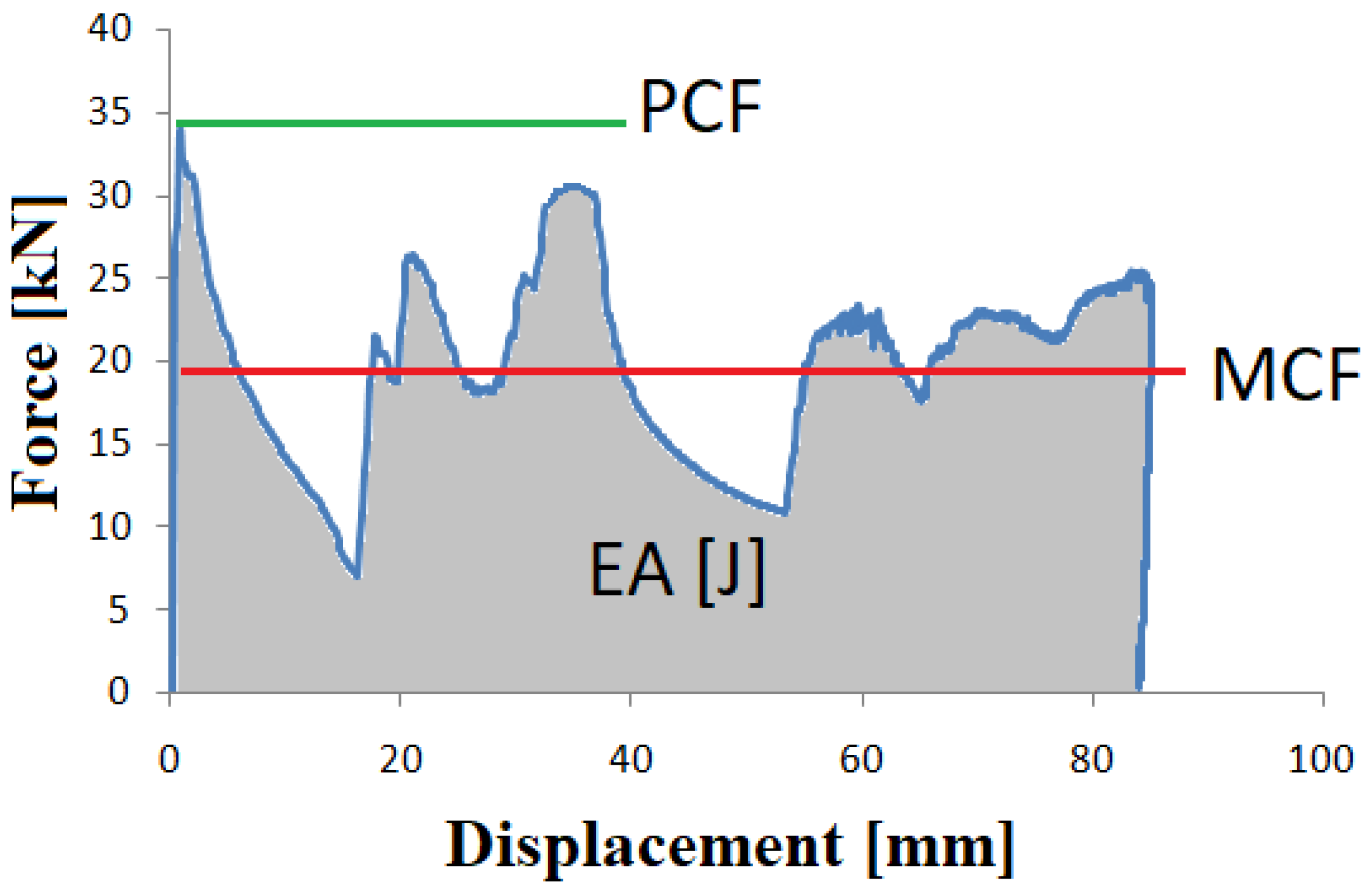
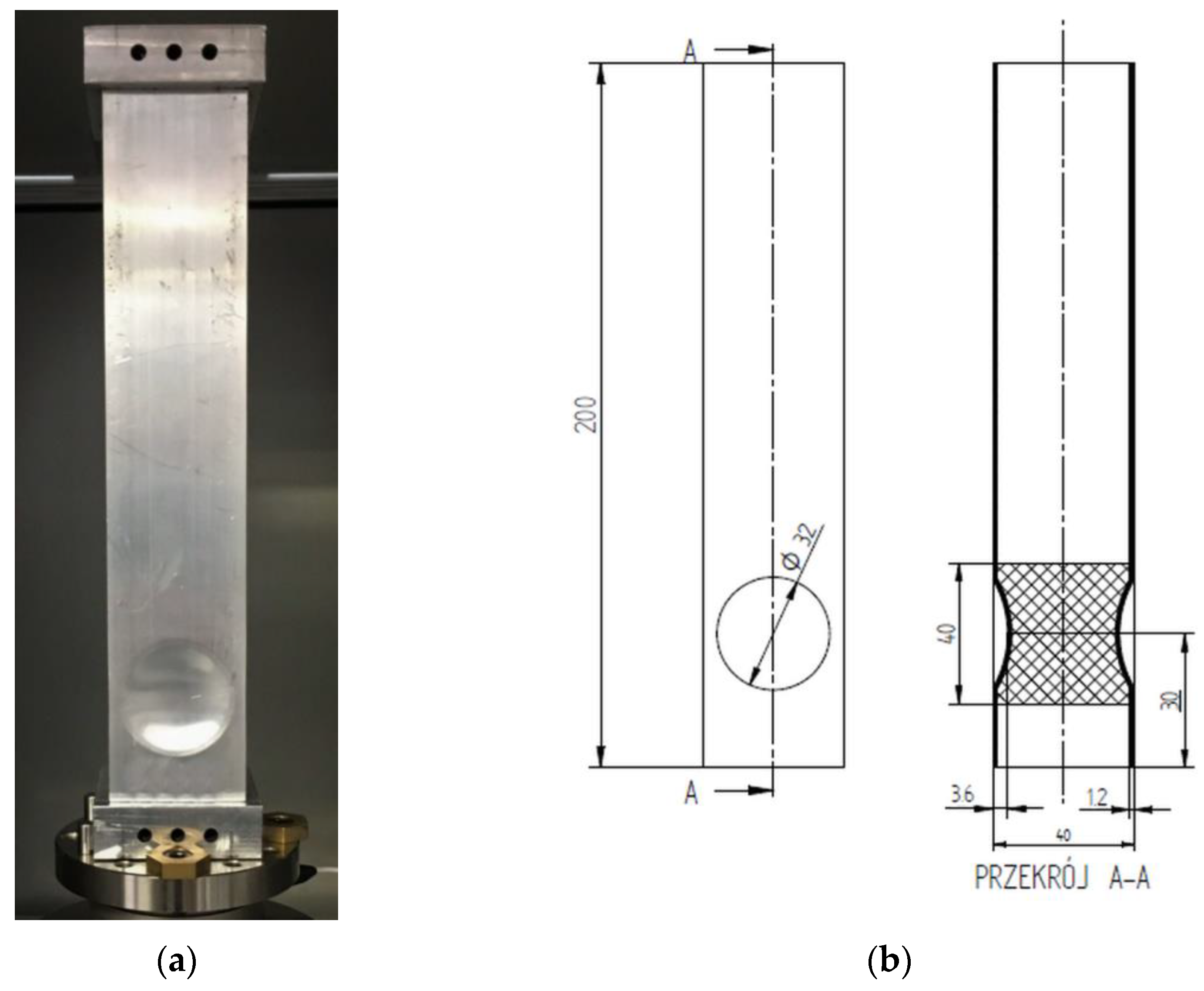
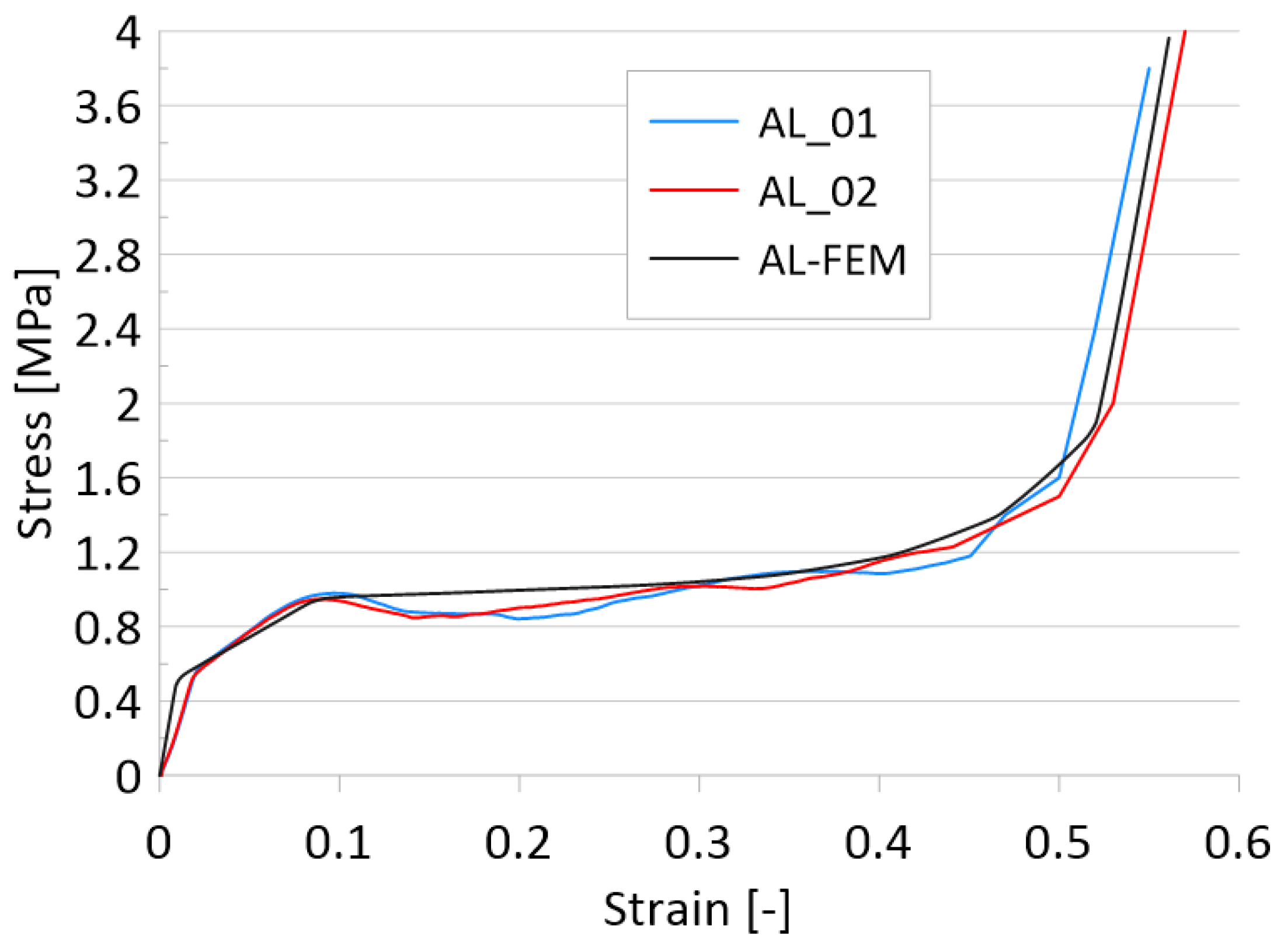
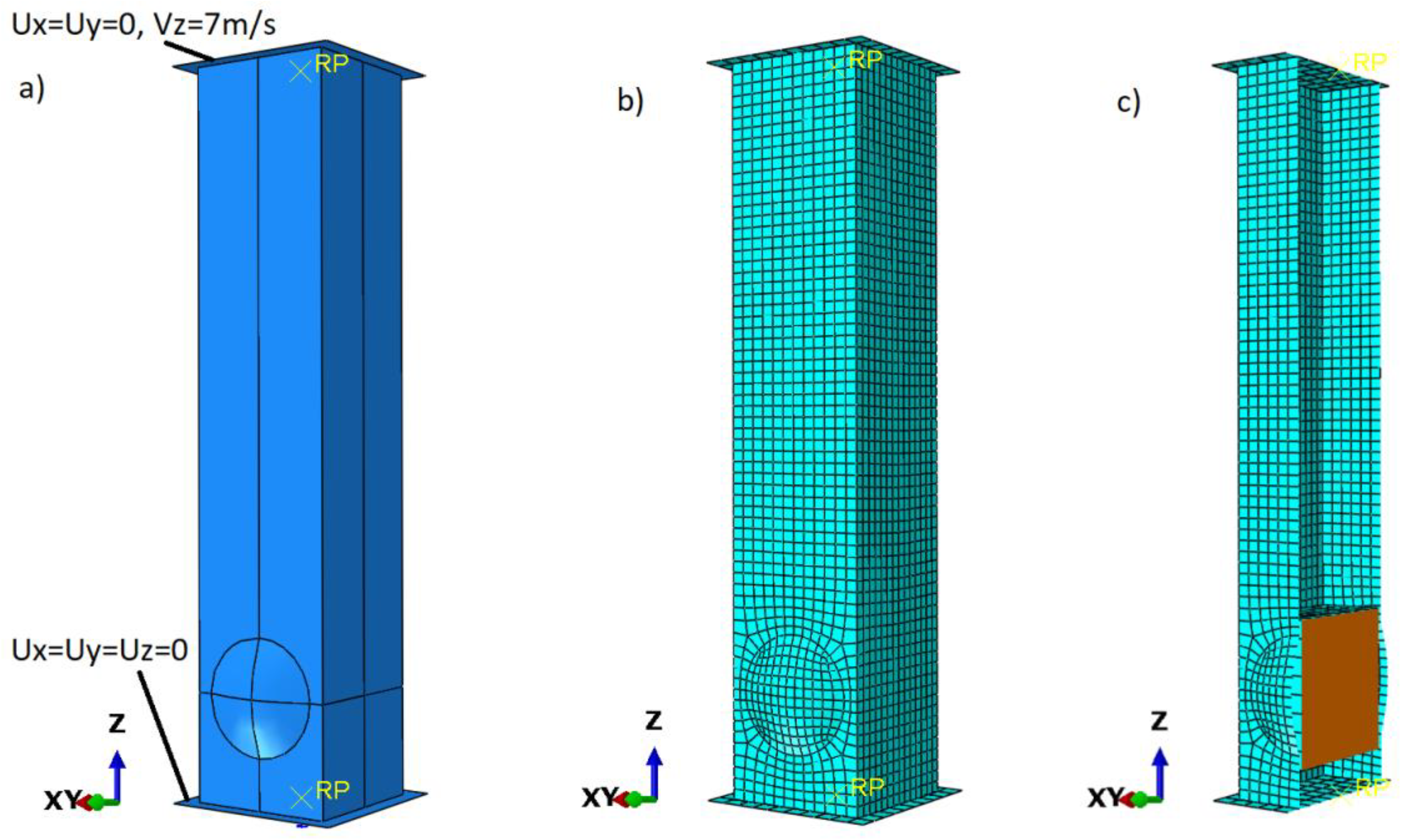
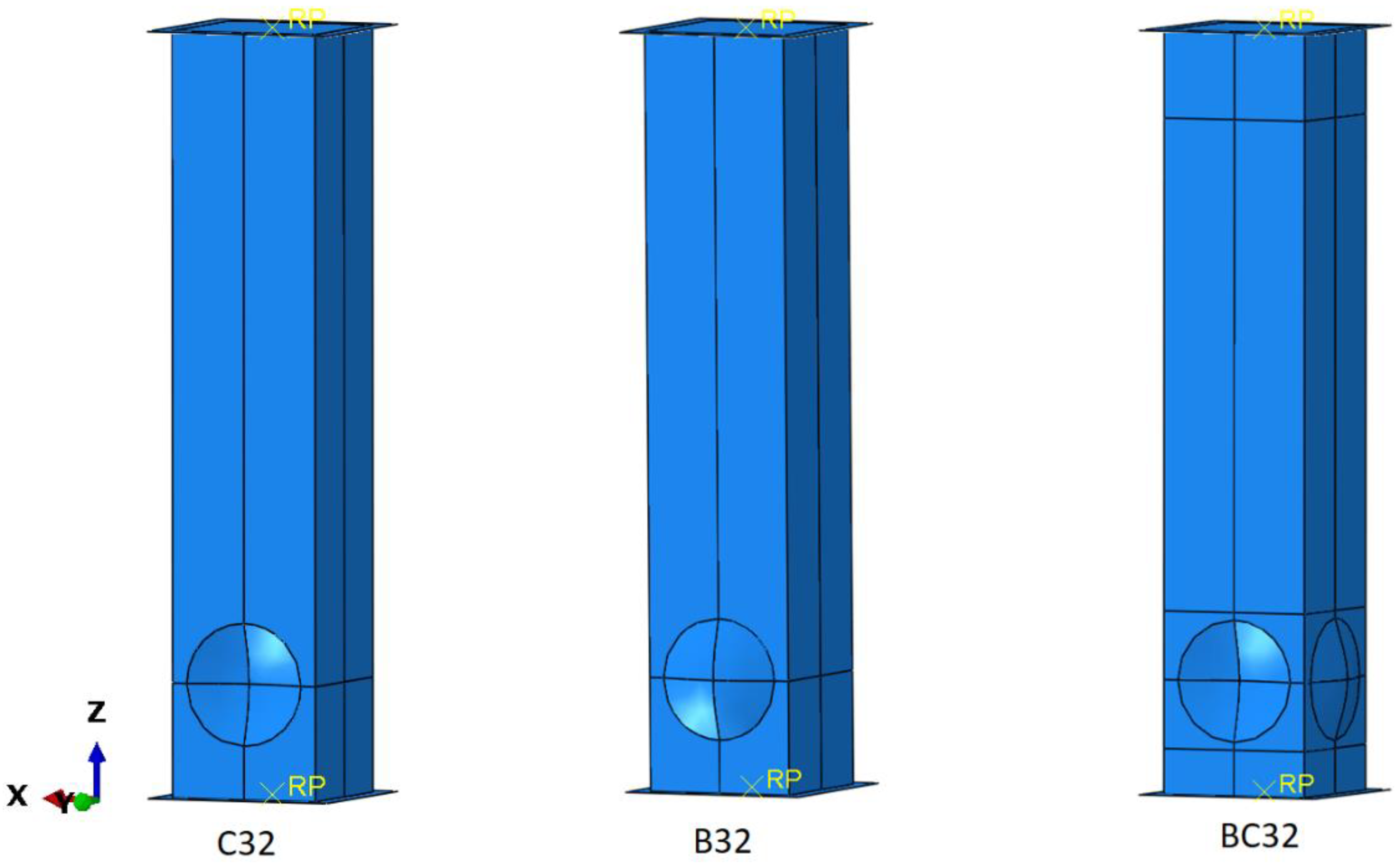
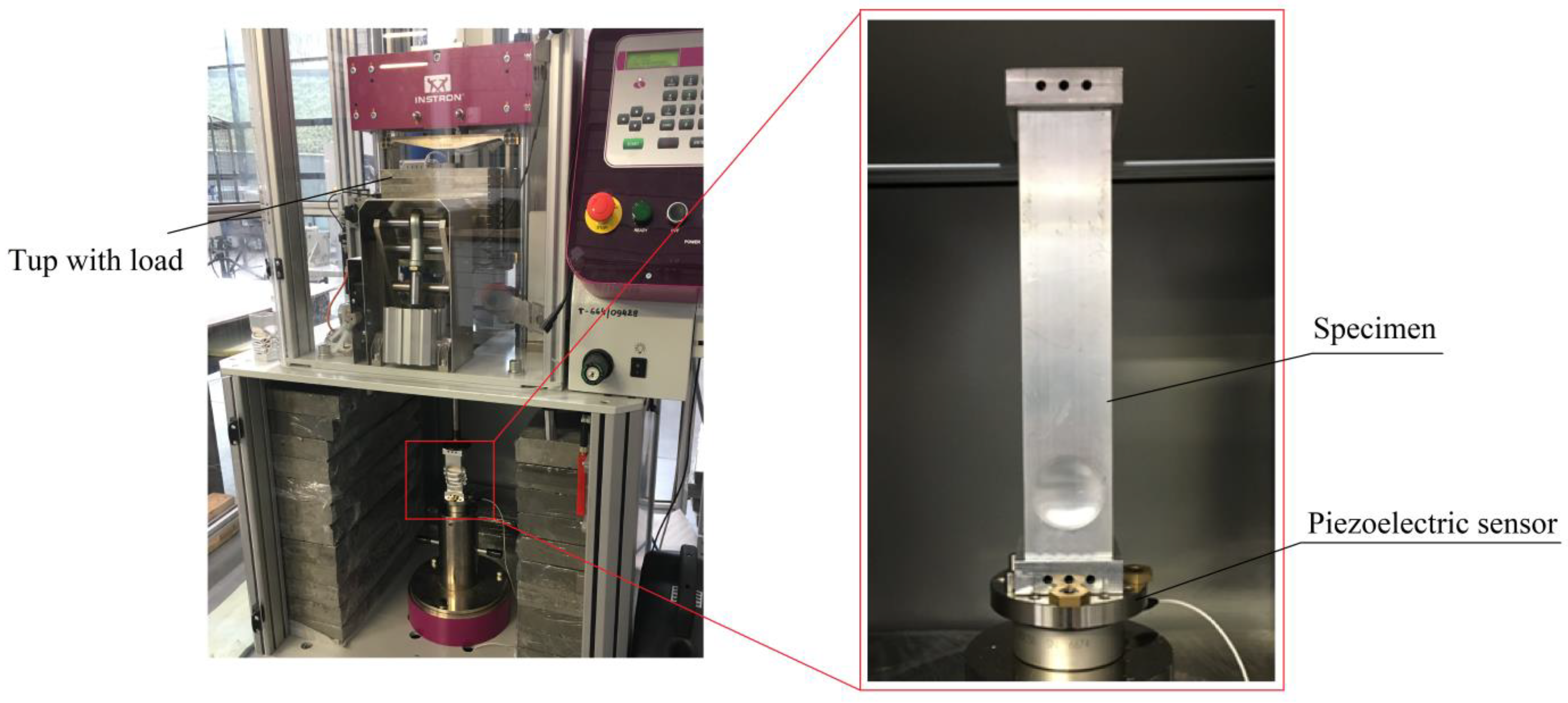
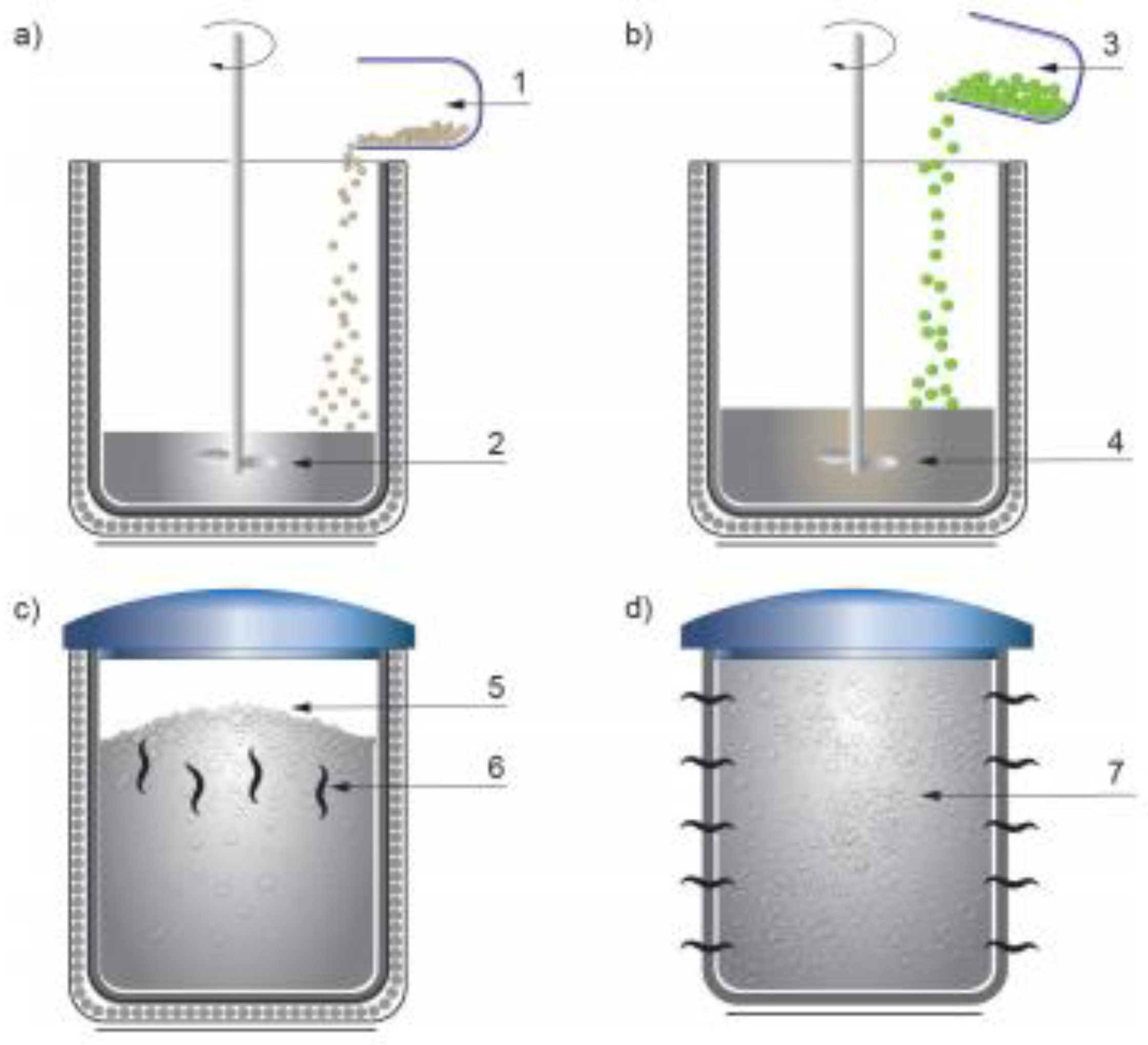
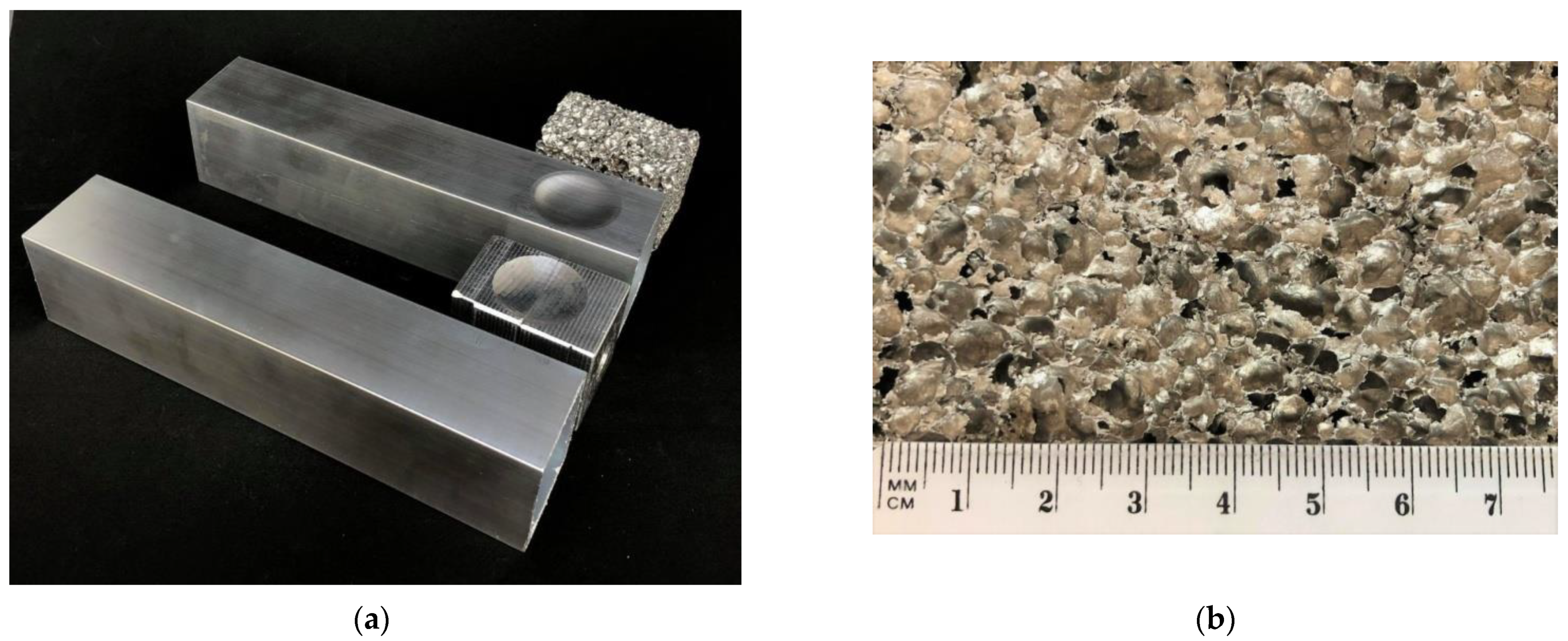
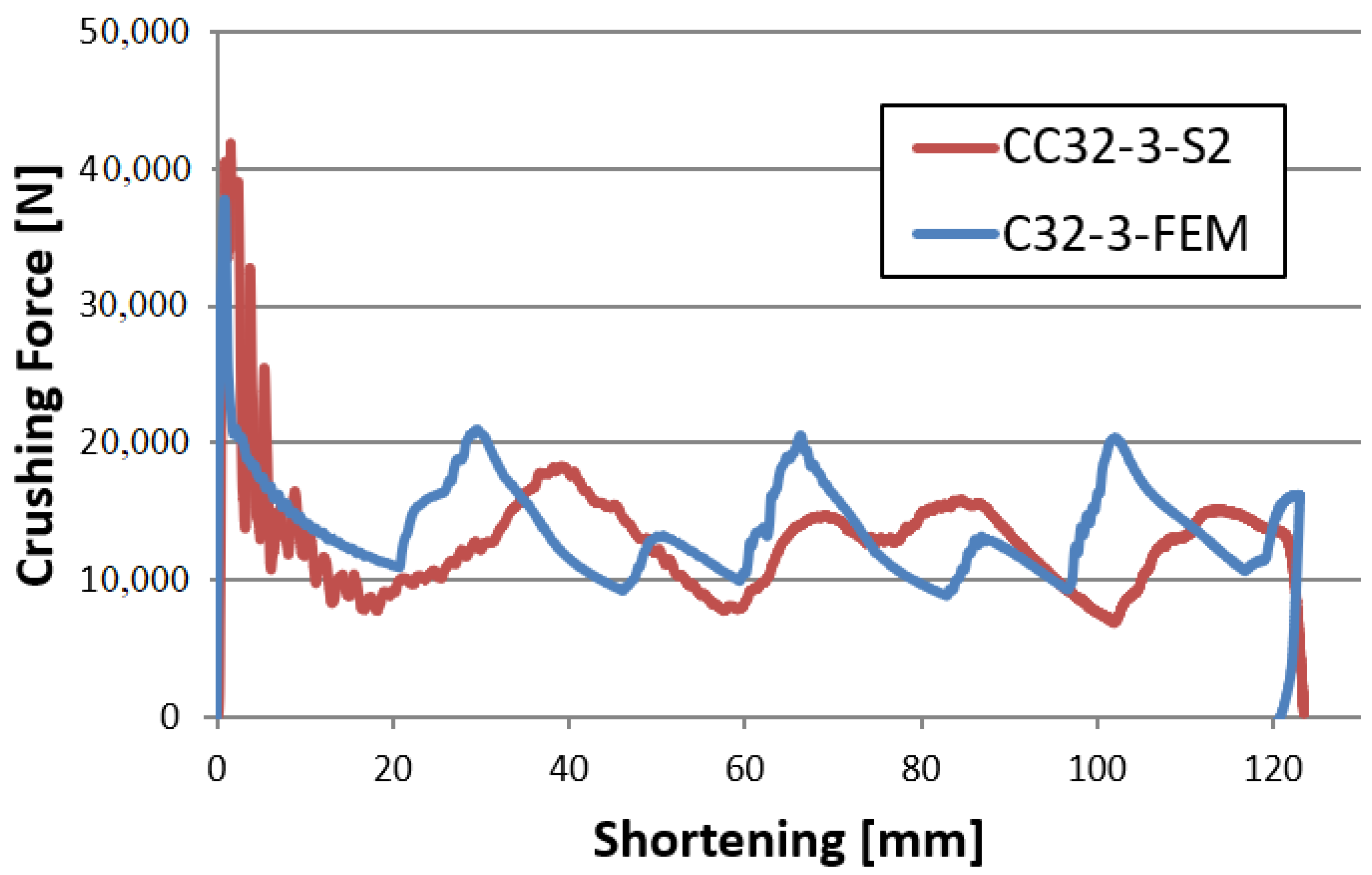
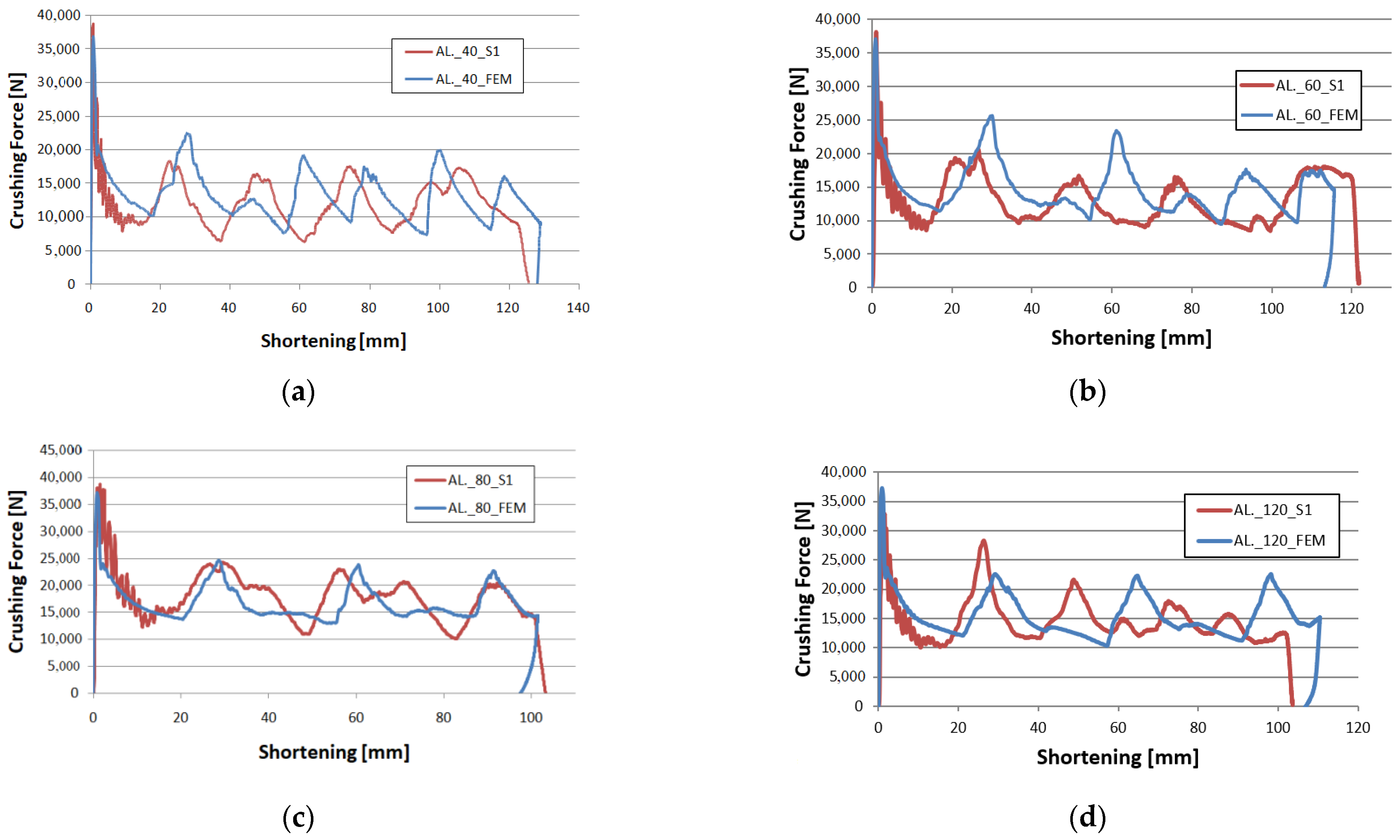

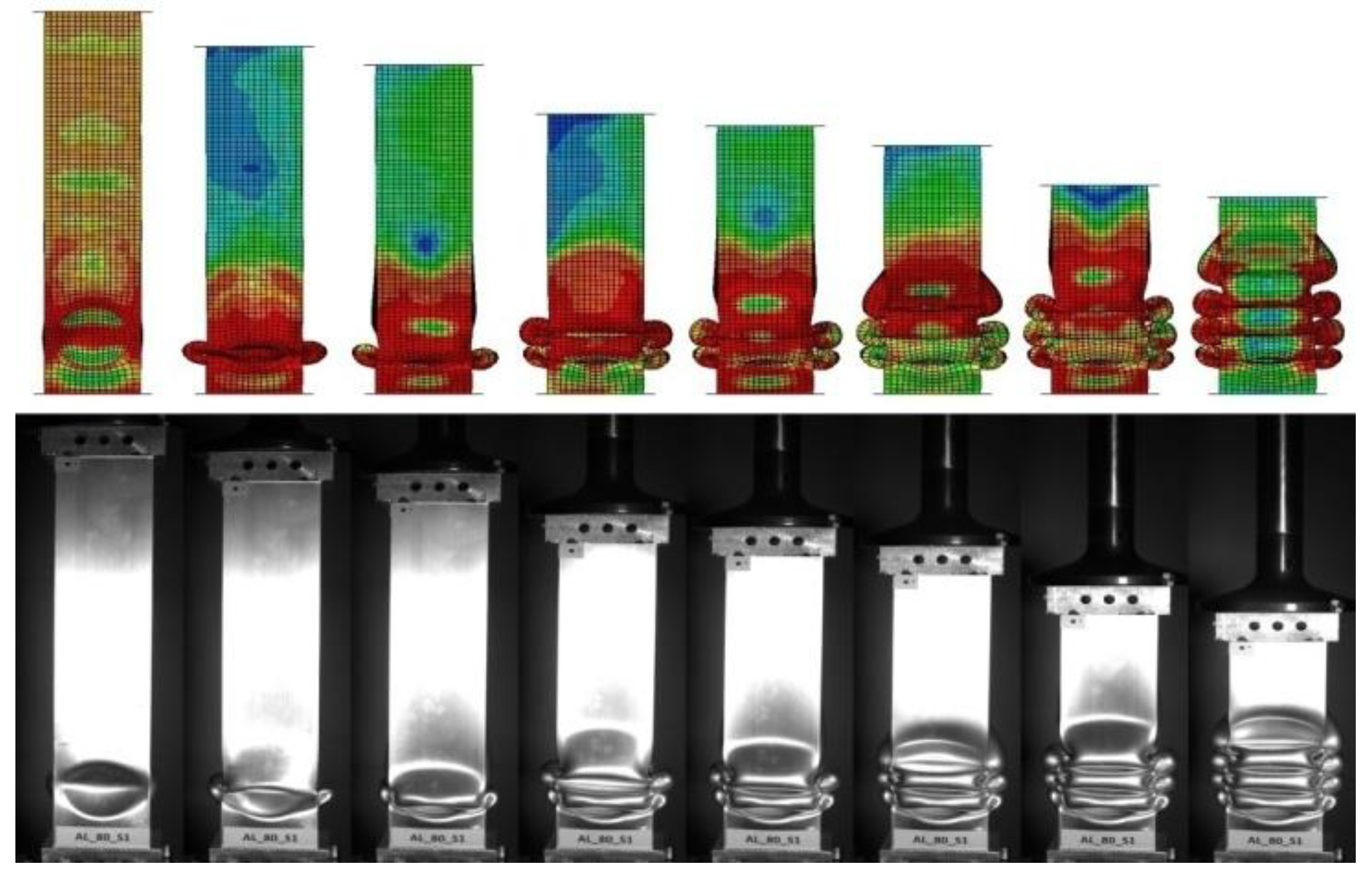


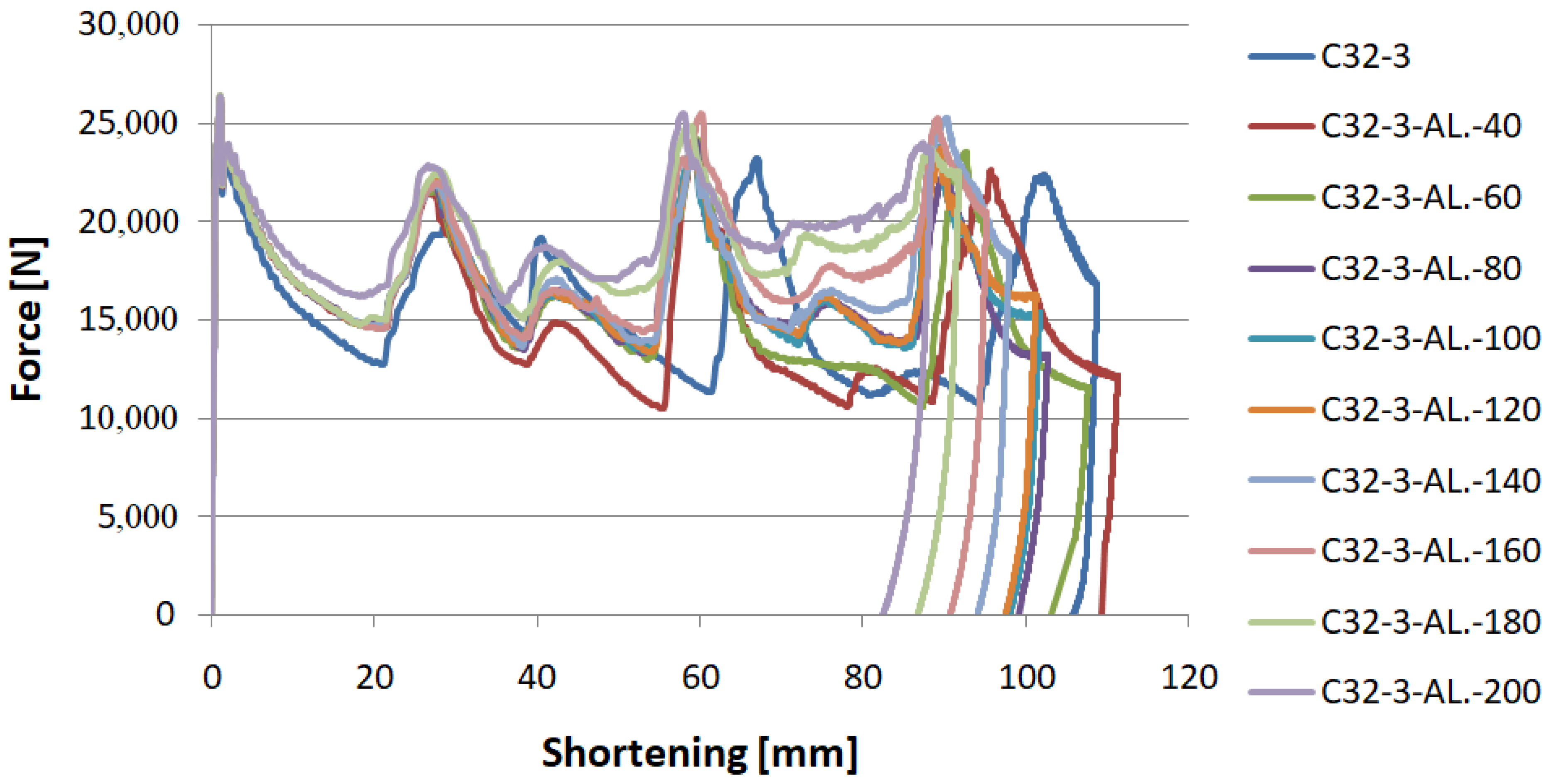
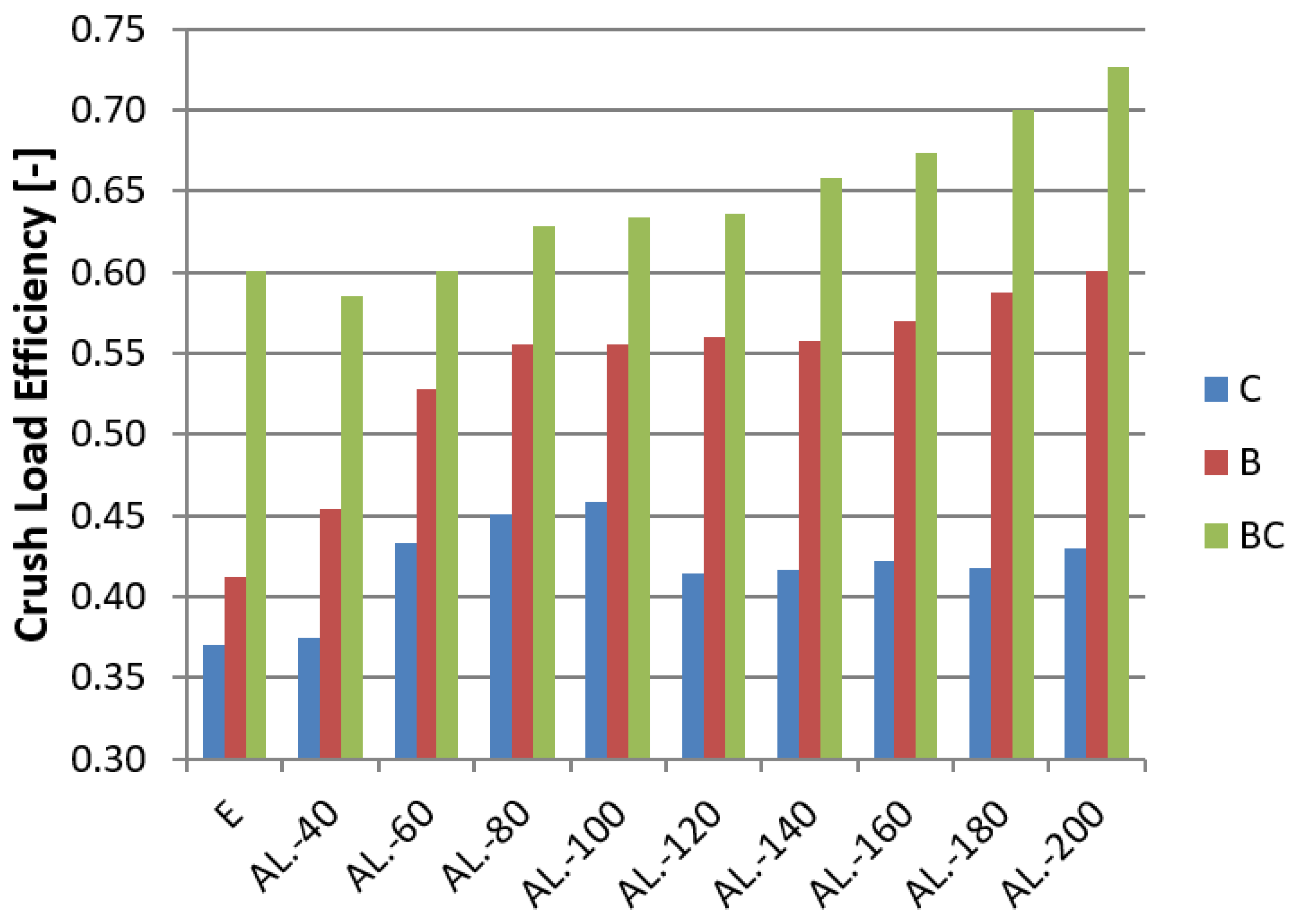
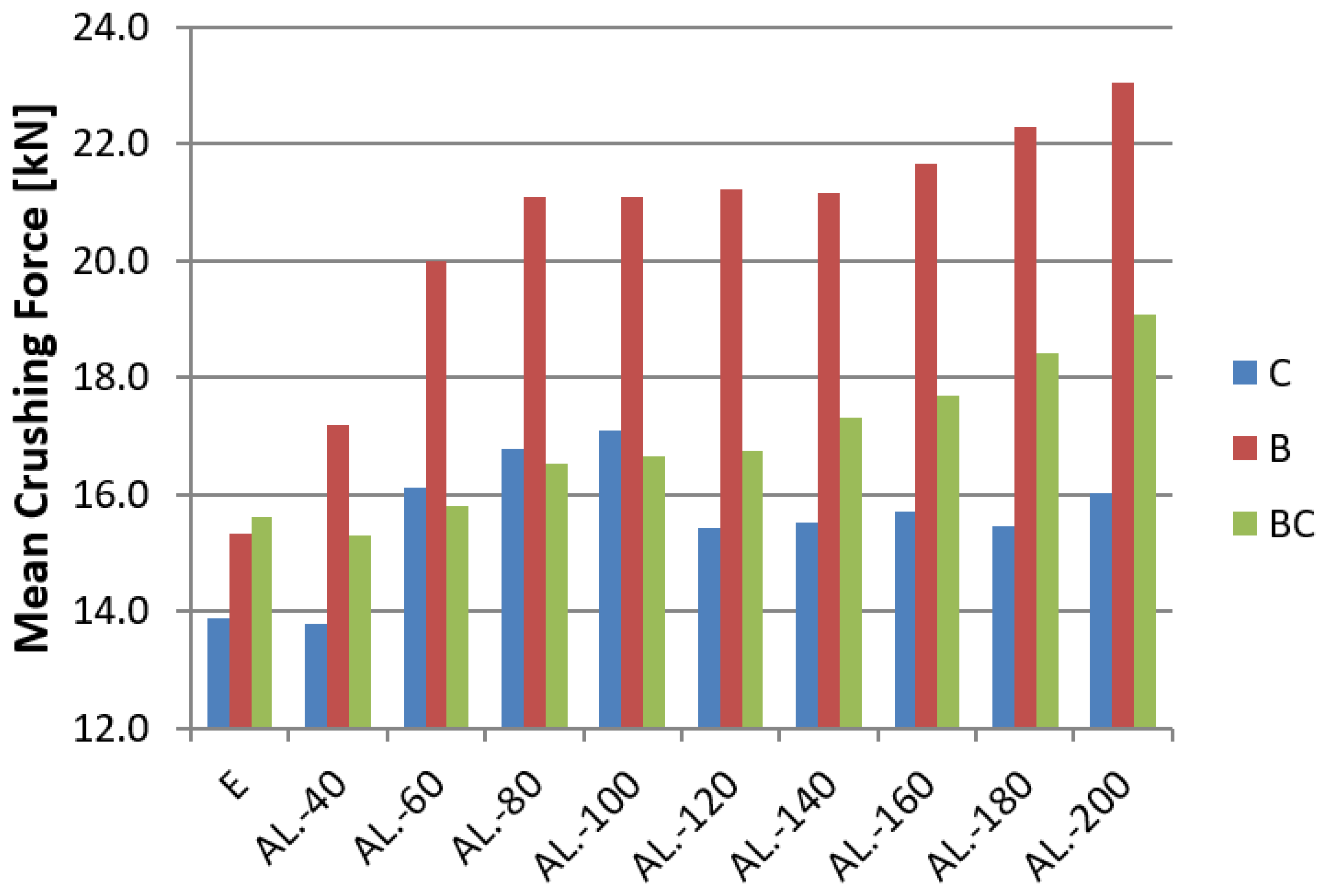
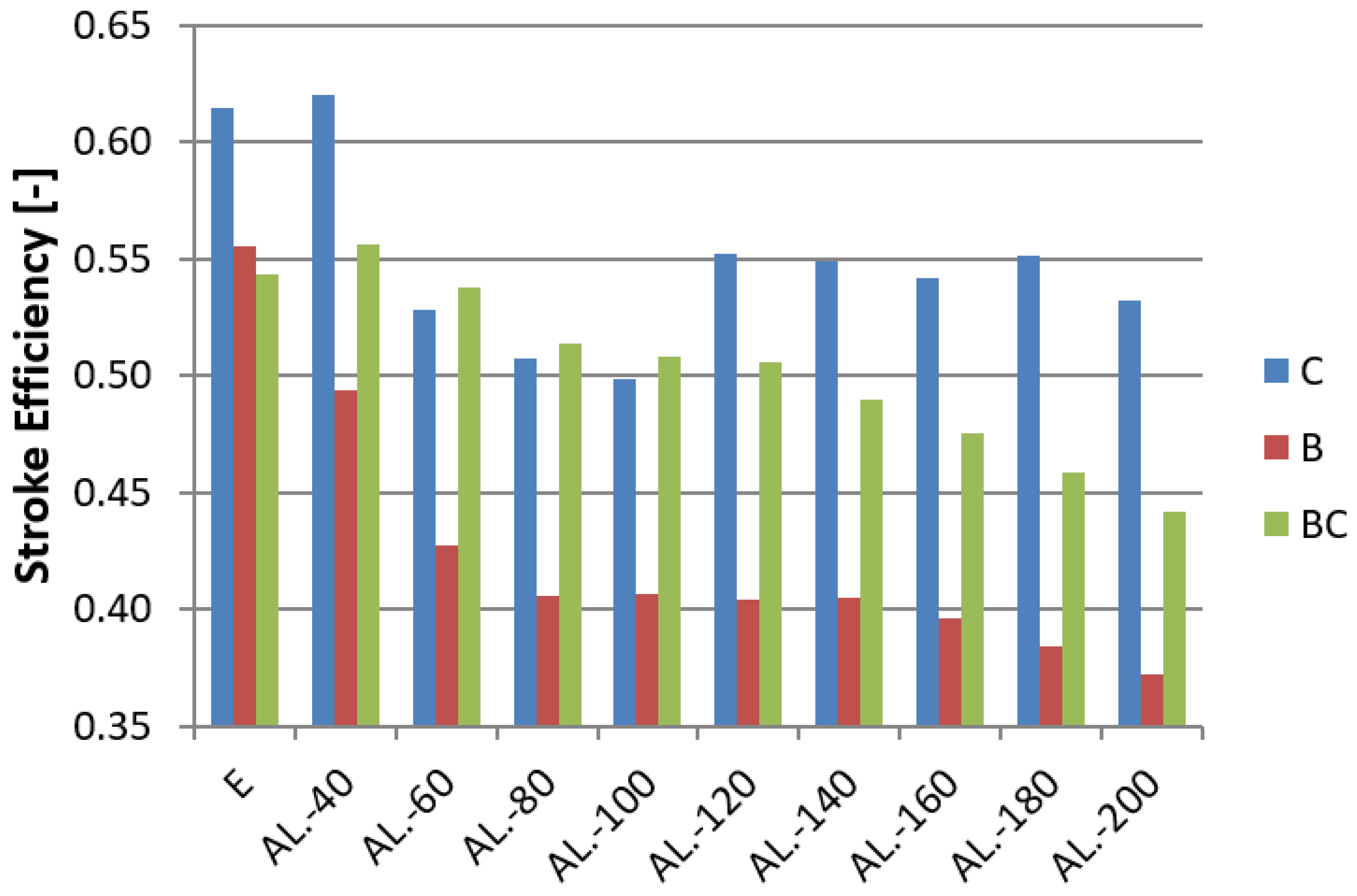
| AA.—6060-T6 | Stress σ [MPa] | Strain ε [‒] | |
|---|---|---|---|
| Density ρ [kg/m3] | 2700 | 200 | 0 |
| Young’s Modulus E [MPa] | 70,000 | 249.35 | 0.00248 |
| Poisson’s Ratio [‒] | 0.33 | 279.98 | 0.0598 |
| Density [kg/m3] | Young’s Modulus [MPa] | Poisson’s Ratio [‒] | Plastic Poisson Ratio νp [‒] | Compression Yield Stress Ratio p0c [MPa] | |
|---|---|---|---|---|---|
| AL | 292 | 60 | 0.33 | 0.015 | 1.702 |
| EA [J] | U Max [mm] | PCF [kN] | MCF [kN] | CLE [‒] | SE [‒] | TE [‒] | ||
|---|---|---|---|---|---|---|---|---|
| C | E | 1707.6 | 122.96 | 37.50 | 13.89 | 0.370 | 0.615 | 0.228 |
| AL.-40 | 1708.2 | 124.00 | 36.78 | 13.78 | 0.375 | 0.620 | 0.232 | |
| AL.-60 | 1701.8 | 105.61 | 37.24 | 16.11 | 0.433 | 0.528 | 0.228 | |
| AL.-80 | 1702.6 | 101.52 | 37.24 | 16.77 | 0.450 | 0.508 | 0.229 | |
| AL.-100 | 1703.7 | 99.65 | 37.24 | 17.10 | 0.459 | 0.498 | 0.229 | |
| AL.-120 | 1703.2 | 110.47 | 37.24 | 15.42 | 0.414 | 0.552 | 0.229 | |
| AL.-140 | 1703.8 | 109.77 | 37.25 | 15.52 | 0.417 | 0.549 | 0.229 | |
| AL.-160 | 1702.3 | 108.33 | 37.24 | 15.71 | 0.422 | 0.542 | 0.229 | |
| AL.-180 | 1706.1 | 110.30 | 37.05 | 15.47 | 0.418 | 0.552 | 0.230 | |
| AL.-200 | 1703.6 | 106.41 | 37.24 | 16.01 | 0.430 | 0.532 | 0.229 | |
| B | E | 1703.2 | 111.06 | 37.22 | 15.34 | 0.412 | 0.555 | 0.229 |
| AL.-40 | 1698.8 | 98.80 | 37.87 | 17.19 | 0.454 | 0.494 | 0.224 | |
| AL.-60 | 1707.7 | 85.42 | 37.89 | 19.99 | 0.528 | 0.427 | 0.225 | |
| AL.-80 | 1712.9 | 81.24 | 37.94 | 21.08 | 0.556 | 0.406 | 0.226 | |
| AL.-100 | 1714.9 | 81.34 | 37.96 | 21.08 | 0.555 | 0.407 | 0.226 | |
| AL.-120 | 1715.2 | 80.84 | 37.90 | 21.22 | 0.560 | 0.404 | 0.226 | |
| AL.-140 | 1714.6 | 81.00 | 37.93 | 21.17 | 0.558 | 0.405 | 0.226 | |
| AL.-160 | 1715.2 | 79.24 | 37.97 | 21.64 | 0.570 | 0.396 | 0.226 | |
| AL.-180 | 1714.1 | 76.93 | 37.91 | 22.28 | 0.588 | 0.385 | 0.226 | |
| AL.-200 | 1715.8 | 74.46 | 38.33 | 23.04 | 0.601 | 0.372 | 0.224 | |
| BC | E | 1698.0 | 108.75 | 25.98 | 15.61 | 0.601 | 0.544 | 0.327 |
| AL.-40 | 1701.3 | 111.28 | 26.14 | 15.29 | 0.585 | 0.556 | 0.325 | |
| AL.-60 | 1700.3 | 107.62 | 26.30 | 15.80 | 0.601 | 0.538 | 0.323 | |
| AL.-80 | 1695.7 | 102.68 | 26.26 | 16.51 | 0.629 | 0.513 | 0.323 | |
| AL.-100 | 1693.6 | 101.68 | 26.28 | 16.66 | 0.634 | 0.508 | 0.322 | |
| AL.-120 | 1693.6 | 101.20 | 26.30 | 16.74 | 0.636 | 0.506 | 0.322 | |
| AL.-140 | 1695.0 | 97.91 | 26.32 | 17.31 | 0.658 | 0.490 | 0.322 | |
| AL.-160 | 1684.4 | 95.14 | 26.28 | 17.71 | 0.674 | 0.476 | 0.320 | |
| AL.-180 | 1689.9 | 91.75 | 26.30 | 18.42 | 0.700 | 0.459 | 0.321 | |
| AL.-200 | 1685.4 | 88.31 | 26.26 | 19.09 | 0.727 | 0.442 | 0.321 |
| EA [J] | U Max [mm] | PCF [kN] | MCF [kN] | CLE [‒] | SE [‒] | TE [‒] | |
|---|---|---|---|---|---|---|---|
| CC32-3-S2 | 1692.36 | 125.50 | 40.234 | 13.485 | 0.3581 | 0.628 | 0.225 |
| C32-3-FEM | 1707.57 | 122.96 | 37.498 | 13.887 | 0.3703 | 0.615 | 0.228 |
| Difference [%] | 0.90 | 2.02 | 6.80 | 2.98 | 3.41 | 2.02 | 1.31 |
| AL._40_S1 | 1692.36 | 125.50 | 38.734 | 13.485 | 0.3481 | 0.628 | 0.218 |
| AL._40_FEM | 1708.20 | 124.01 | 36.780 | 13.780 | 0.3750 | 0.620 | 0.232 |
| Difference [%] | 0.94 | 1.19 | 5.05 | 2.19 | 7.72 | 1.20 | 6.20 |
| AL._60_S1 | 1701.92 | 121.93 | 38.182 | 13.958 | 0.3656 | 0.610 | 0.223 |
| AL._60_FEM | 1689.43 | 115.53 | 37.105 | 14.624 | 0.3941 | 0.578 | 0.228 |
| Difference [%] | 0.73 | 5.25 | 2.82 | 4.77 | 7.81 | 5.25 | 2.15 |
| AL._80_S1 | 1702.47 | 103.24 | 38.954 | 16.490 | 0.4233 | 0.516 | 0.219 |
| AL._80_FEM | 1702.64 | 101.52 | 37.243 | 16.772 | 0.4503 | 0.508 | 0.229 |
| Difference [%] | 0.01 | 1.67 | 4.39 | 1.71 | 6.38 | 1.67 | 4.61 |
| AL._120_S1 | 1741.28 | 102.67 | 36.654 | 16.027 | 0.4373 | 0.513 | 0.224 |
| AL._120_FEM | 1703.23 | 110.47 | 37.239 | 15.417 | 0.4140 | 0.552 | 0.229 |
| Difference [%] | 2.19 | 7.60 | 1.60 | 3.80 | 5.32 | 7.60 | 1.88 |
Publisher’s Note: MDPI stays neutral with regard to jurisdictional claims in published maps and institutional affiliations. |
© 2021 by the authors. Licensee MDPI, Basel, Switzerland. This article is an open access article distributed under the terms and conditions of the Creative Commons Attribution (CC BY) license (https://creativecommons.org/licenses/by/4.0/).
Share and Cite
Rogala, M.; Ferdynus, M.; Gawdzińska, K.; Kochmański, P. The Influence of Different Length Aluminum Foam Filling on Mechanical Behavior of a Square Thin-Walled Column. Materials 2021, 14, 3630. https://doi.org/10.3390/ma14133630
Rogala M, Ferdynus M, Gawdzińska K, Kochmański P. The Influence of Different Length Aluminum Foam Filling on Mechanical Behavior of a Square Thin-Walled Column. Materials. 2021; 14(13):3630. https://doi.org/10.3390/ma14133630
Chicago/Turabian StyleRogala, Michał, Mirosław Ferdynus, Katarzyna Gawdzińska, and Paweł Kochmański. 2021. "The Influence of Different Length Aluminum Foam Filling on Mechanical Behavior of a Square Thin-Walled Column" Materials 14, no. 13: 3630. https://doi.org/10.3390/ma14133630
APA StyleRogala, M., Ferdynus, M., Gawdzińska, K., & Kochmański, P. (2021). The Influence of Different Length Aluminum Foam Filling on Mechanical Behavior of a Square Thin-Walled Column. Materials, 14(13), 3630. https://doi.org/10.3390/ma14133630







